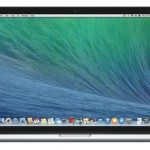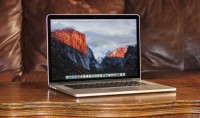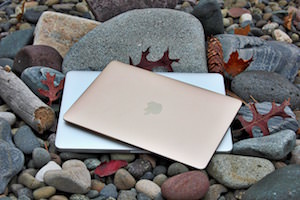Choosing an Apple MacBook Pro with Retina Display laptop — and/or a MacBook Pro with Touch Bar and Touch ID — can be a nerve-wracking decision, but it doesn’t have to be once you understand the core elements that really matter.
To start, the MacBook Pro 13 and 15-inch with Retina Display MacBook Pro with Touch Bar and Touch ID are oxymorons: They are advanced marvels of engineering that are hobbled by non-upgradable memory and mostly non-upgradable storage capacities. The very things that make them awesome — like super-fast flash-based storage — also hold them back. You must choose wisely.
Fortunately, the MacBook Pro 13 vs 15 decision is easier when you ignore most of the tech specs and focus on a few key questions.
First, Apple’s new 13-inch and 15-inch MacBook Pro models all come with Retina displays. All 15-inch MacBook Pro models now come with Apple’s new Touch Bar and Touch ID. The Touch Bar replaces the old top line of function keys in older MacBooks and most PC laptops. The Touch ID is a fingerprint recognition button for login and ID-related activities like downloading movies from iTunes or buying things online with Apple Pay.
Most 13-inch MacBook Pro models have the new Touch Bar and Touch ID, which Apple identifies as “Touch Bar with integrated Touch ID sensor” but Apple also offers a 13-inch MacBook Pro option without a Touch Bar or sensor. This 13-inch MacBook Pro without the Touch Bar and sensor, by the way, is actually the best MacBook Pro for most people — so let’s get this topic out of the way right now.
Is the new MacBook Pro Touch Bar with Touch ID sensor worth it?
Short answer: No. The long answer: It’s mostly only important for specialized professional-grade applications for people who really want to use the Touch Bar. For instance, some high-end graphics applications will use the Touch Bar to offer color or graphic design controls. Because all this is software-based, application developers might build useful features into the Touch Bar to make their applications more powerful or user-friendly.
Maybe.
From what I’ve personally experienced and have been hearing, the Touch Bar isn’t a very natural bar to use — heck, the whole point of the keyboard is to not look at it while I look at the app I’m using. That said, it does do some interesting things. For instance, it adds some controls to video playback that are nice, making it easy to skip forward or back. It offers a bunch of emojis if you’re into emojis. And it does some typing predictions — like on your iPhone’s Messages app — that you can use. If you have an injury or disability, this last feature might be the most useful thing in the Touch Bar. As for other controls, I lost the ability to hit one physical old-school key to turn the volume up or down. Now I have to touch the Volume button to reveal a slider. The Touch Bar created an extra step for something I use every day.
As for the Touch ID, most people seem to like it, and it has worked great for me. It’s fast and rarely fails to read my finger prints.
So the big question is, if you’re considering a 13-inch MacBook Pro, is the Touch Bar worth $300?
Sure, there are very minor differences in processor speed, built-in graphics, and two-vs-four USB-C ports between the 13-inch MacBook Pro with Touch Bar and the one without it. The most important difference is the Touch Bar, and in my opinion it’s not worth a $300 price premium. In fact, after using my 15-inch MacBook Pro with Touch Bar for several months, if I could have saved $300 off the price of my 15-inch MacBook Pro with Retina and Touch Bar, I would have ditched the Touch Bar and spent the savings on other Apple gear in a heartbeat.
MacBook Pro 13 or 15?
All that said, the new MacBook Pros are high-end devices that come with high-end price tags. The biggest potential buying issue is storage. The base models all come with 256GB of built-in, non-upgradable storage. Is this enough for you? That’s your primary question with these new models. If you’re the kind of person who wants to backup your 128GB iPhone to your MacBook Pro, as well as have a photo library of photos and videos — not to mention back up more than one iPhone in your household — 256GB just might not be enough to do this easily.
Your next major decision factor is price. How much are you willing to spend?
If your budget matches your storage needs in a new MacBook Pro, you’re going to be happy. If your budget isn’t quite there, your best option might be to go with the entry-level 13-inch MacBook Pro without Touch Bar because it may be possible to use a third-party to upgrade the SSD drive sometime in the future to give you more storage — maybe. The new 15-inchers are pretty much impossible to upgrade.
But even so there is a wrinkle: OWC, which is a third-party manufacturer of Mac upgrades, has invented the OWC DEC, which is a base that you can attach to the bottom of your svelte 2016 MacBook Pro to give you an additional attached storage option. That isn’t slated to arrive until late 2017 though. Still, it’s a great idea and could give you some storage breathing room if you’re budget is tight right now.
If you don’t care about the new Touch Bar, you might be able to find a better deal on a previous generation MacBook, MacBook Air, or MacBook Pro.
13 vs 15 MacBook Pro Value: Is price a factor?
If you’re in a budget-sensitive situation, we can stop this conversation right now: Choose the entry-level 13-inch MacBook Pro and change your usage habits to match your budget. How? When you need more storage than the 256GB, get a Thunderbolt or USB 3.0 external hard drive to hold your extra media files (like movies) or start using high-capacity USB thumb drives.
Instead of letting your Photos library explode with photos, get ruthless and only pack around the photos you really love on your Mac. And, when you plan on sitting at a desk and working long hours, invest in an eternal monitor. I have a 15-inch MacBook Pro and I still find myself using my 24-inch Dell monitor for much of my workday.
The point is, if you can learn to store large files externally, a 13-inch MacBook Pro will serve you well for years to come, especially if you’re a home user or a student.
Conversely, if price is not a problem, stop worrying and buy the MacBook Pro 15 with 512 GB of storage and the better graphics processor. Your experience will be so good, most every other laptop screen will make you feel like there’s sand in your eyes.
Do you need a big screen?

Which MacBook Pro? The 13.3 inch or 15.4 inch, and how much flash storage? The 13-inch is best for most people, the 15-inch best for heavy workloads. Take action: check models and prices at Amazon.
The new Retina displays on the MacBook Pro 13 and MacBook Pro 15 are slightly different, and the way the resolution of a Retina display is utilized means that the actual pixels (tiny dots of light) packed onto the screen don’t map to workable space like they used to years ago — especially when you’re working with image files. Both displays look fantastically crisp, bright, and vivid. The 15.4-inch screen simply has more available real estate to work with, and that’s the key: Do you need all you can get?
To get that screen real estate, though, requires a major price leap: $700 more if you consider the low-end and $500 more if you want to compare the mid-level MBP 13, which has 8GB of memory and 256GB of storage. Of course, the entry-level 15-inch MacBook Pro now has 16GB of memory and 256GB of storage, giving you a boost in memory, which is worth it if you get into editing a lot of video, playing intense games, or working with a lot of different apps at the same time.
Unfortunately, Apple has this whole pricing fetish that’s attached to size — bigger screens always cost more. If you’re like me, you would appreciate a mid-level MacBook Pro that has mid-level processors . . . but still has a larger screen. Sorry, with Apple, “bigger” and “better” always go hand-in-hand. Consequently, if you need more working space directly on your MacBook Pro, you must get the pricier model.
When you travel, will you need to do serious work for long hours?

Review Takeaway: The 13-inch MacBook Pro with Retina display is the best all-around MacBook for most consumers.
If you travel and work a lot, you need to consider the nature of your work: Will you lose productivity if your screen size is smaller than at your office desk? For me, writing and working simply takes longer on a smaller screen. No way around it. When I travel, I lose a bit of productivity, and for me, productivity is key. I can’t imagine going back to any screen smaller than a 15-incher.
On the other hand, if your travel requires you to pull your MacBook Pro out and use it for short bursts of activity several times a day — say, in airports and lobbies and remote offices or coffee shops, libraries, and classrooms — for things like email, word processing, and web browsing . . . the portability of the 13-inch MacBook Pro wins. Which leads to the next question.
Will you pack your MacBook Pro around a lot?
If you’re a student or a person who can’t leave home without your MacBook, go with the MBP 13 (or a MacBook Air). At 3.46 pounds, it weighs only one pound less than the 4.46 pound MBP 15, but the smaller footprint and weight will make it feel much more nimble.
Are you a pro? A movie-making enthusiast or gamer?
If you’re a pro, I’m surprised you’re reading this. Buy the MBP 15 for the quad-core Intel Core i7 processor and get on with it. The MBP 13s come with dual-core Intel Core i5 processors. For intensive applications, you’ll want the MacBook Pro 15-inch models.
If you’re a video enthusiast on a budget, you can get by with the $1499 or $1799 MacBook Pro 13-inch models (usually less at B&H), but if you’re a Mac-loving user who simply has an unbearable desire to play rich, vibrant games on your Mac, go big with a stacked 15-inch MacBook Pro.
Here’s one last thought: Don’t fret so much in your decision. If you make a mistake, your MacBook Pro will hold its value well. You can sell it and only lose a small chunk of your investment. In the process, the consolation is that you will have learned something valuable about yourself — and your real MacBook Pro needs.
What about the new Force Touch trackpad on the 13-inch MacBook Pro?

Review: The 15-inch MacBook Pro with Retina display (Mid 2015) is Apple’s most powerful notebook.
Apple recently updated the 13-inch MacBook Pro with Retina display and 15-inch MacBook Pro with Retina display with slightly improved graphics, faster flash storage, and Apple’s new Force Touch trackpad. The performance boost is welcome — but not a factor compared to the 15-incher. The new trackpad, though, is a matter of personal preference. Why? It has two features that are interesting but far from necessary — vibration feedback for some types of presses and an ability to press and then press harder to trigger an action. For example, if you tap on a date in an email and then continue to press harder, you can automatically open up a calendar entry. Or if you fast forward in a movie and press harder, it will fast forward faster. Cool? Yes. Life changing? No. (Heck, I still prefer to use a Magic Mouse 2.) Bottom line? If you need a MacBook now, I recommend that you choose based on screen size and storage capacity.
Shop MacBook Pro 13 vs 15 Retina Display:
- Get the MacBook Pro 13.3-inch, 128GB, 256GB, 512GB at Amazon . . . or at B&H
- Get the MacBook Pro 15.4-inch, 256GB, 512GB, 16GB memory at Amazon . . . or at B&H
- SanDisk Ultra Fit 128GB USB 3.0 Flash Drive
- LaCie Rugged Thunderbolt & USB 3.0 1TB External Hard Drive
- Viewsonic 24-inch Widescreen LED Monitor with Full HD 1080p and Speakers








